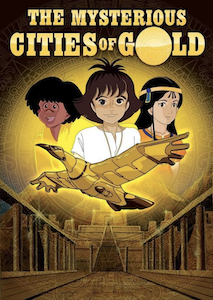|
The Mysterious Cities of Gold (Taiyo no ko Esuteban in Japanese and Les Mysterieuses Cities D'Or in French) is a 1982 French-Japanese, animated, television series. The co-writers of this included Jean Chalopin and Bernard Deyries, and it's quite loosely based on the novel, The King's Fifth, authored by Scott O'Dell. Co-production was by DIC Audiovisuel, Studio Pierrot, NHK, MK Company, and Radio Television Luxembourg - Television Independante (RTL - TVI). The series would be revived 30 years later as a continuation of it in 2012.
Plot[]
In the 16th century, European explorers set sail from their continent to the New World, seeking adventure and wealth in the Americas. A pre-teen, Spanish boy named Esteban is raised by a navigator named Mendoza, who rescued him when the former was a baby at sea. Esteban's real father is thought to have perished, so Mendoza becomes a surrogate father figure to him. When Esteban hears that his father may actually still be alive years later, he decides he wants to go on the voyage to find him. He travels with Mendoza and his comrades, Sancho and Pedro. Later, an Incan girl named Zia and Tao, a native boy of the Mu (Hiva in the English dub) tribe, and who is also the last, surviving member of it, accompany them. They go through a series of challenges and obstacles before they can achieve their goals, searching for the missing Seven Cities of Gold and finding Esteban's father.
Why It Rocks[]
- The anime-influenced art style brings a refreshing sensibility through the collaboration of the two countries' studios. The animation is lush and although the look of it is elegant, it would be even better in the 2012 series.
- The writing is spectacular, especially since the episodes' plots make up a story arc and it's one of those shows designed as such. Because of this, they provide plenty of excitement.
- Several of the characters, especially the protagonists, are likable in their nobility.
- The character designs look good enough.
- An enduring theme song that remains as one of the most memorable to this day. The French version may be even more so.
- The voices in the English dub sound easily performed and plenty of effort was put into them.
- It features an intriguing mix of ancient and modern technology, like the Golden Condor, as well as the blend of history and sci-fi.
- Some comedic moments, mainly with Sancho and Pedro (but that may depend on your view) and poignant moments.
- The live-action footage involving historical facts after each episode are fascinating.
- Charming backgrounds and sceneries.
- It was among the imported shows that aired on Nickelodeon before original shows were made for the channel, introducing it to the American audience.
- The action moments are thrilling.
- Coincidentally enough, it shares similarities with another Japanese, animated series that came out a few years earlier called The Adventures of Pepero, but at the same time, it's still different in its own right.
- It spawned a couple computer games.
- It simply remains a beloved, worthy classic to this day.
Bad Qualities[]
- It took three decades for the series to continue. It's unfortunate that more episodes couldn't had been made in the '80s due to more focus being put on Inspector Gadget (1983), but better late than never.
- Depending on one's view, some may find Sancho and Pedro to be nuisances rather than comic reliefs.
- Some parents may have issues with the mild expletive, "damn", being used twice in a show mainly for kids.
- Another adaptation and shorter-lived-series-turned-film, Esteban and Zia In Search of The Seven Cities of Gold, is alright as its own thing, but wasn't as well-received.
- For years, there's been mention of a feature-length film version of this that has yet to materialize.
- The 2012 series was not well received due to it ignoring the conclusion of the original.
